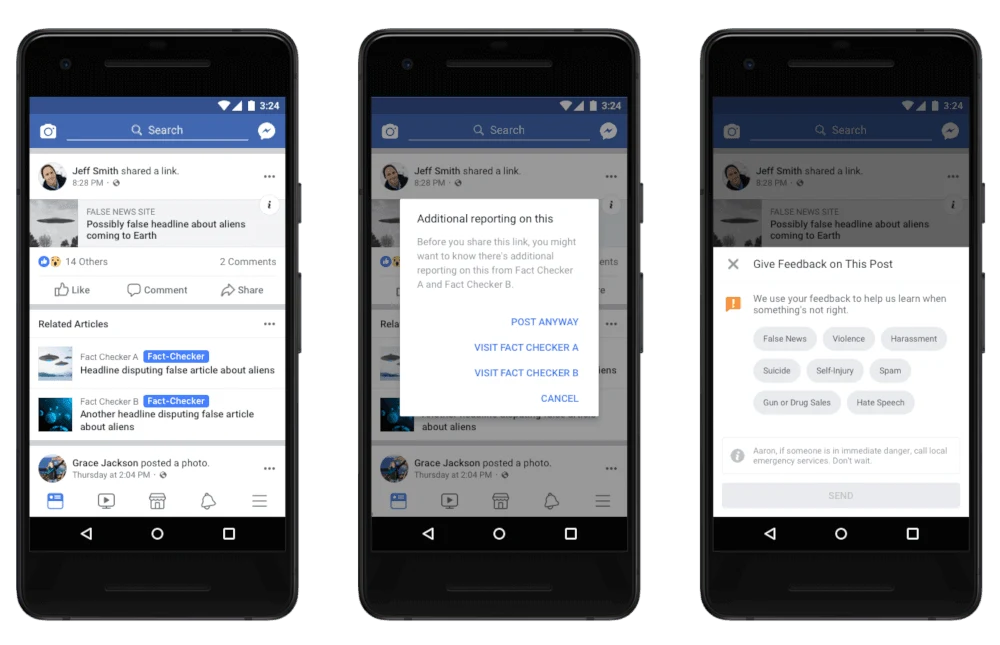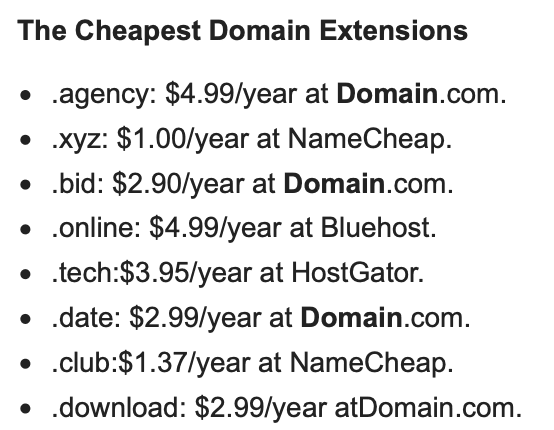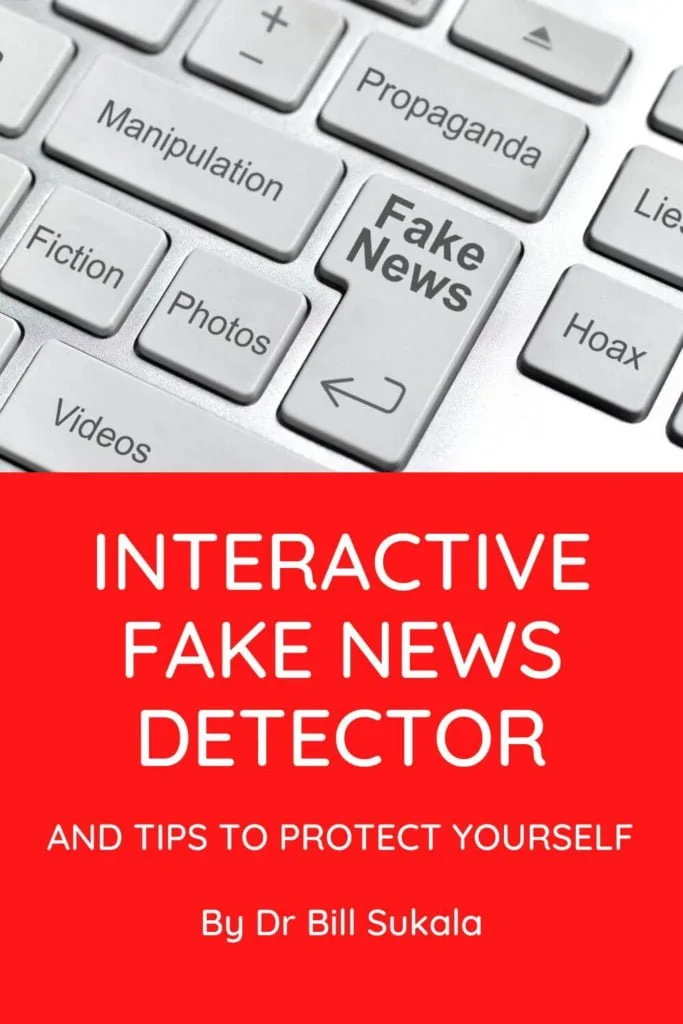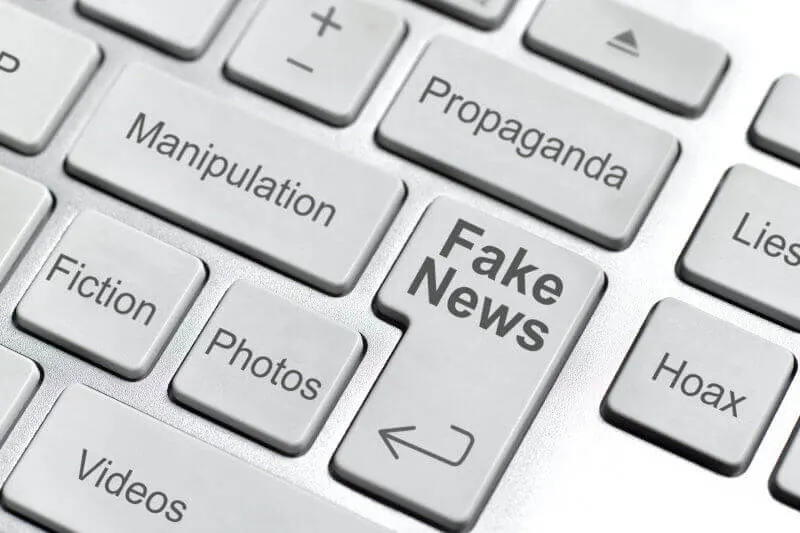How do I know it’s fake news?
In this post-truth era of fake news, you’re bulldozed by a daily tsunami of information, misinformation, and disinformation, and it is critical to know what’s legit and what’s not.
You must become a rabid pitbull guarding the gates to your mind because fake news (and, more recently, virus-related conspiracy theories) is an ever-present poison that will infect you and colour your perceptions of the world.
However, the thing about fake news is that there are common red flags that can tip you off to which news items are likely false or misleading.
Therefore, the purpose of this interactive fake news detector is to give you a tool you can use to sift through the latest news stories.
Please help stop the spread of fake news by sharing this tool on social media, linking to it from your website, bookmarking it in your browser, and sending to others who may need help in spotting fake news.
Try the fake news detector
Fake news facts and further reading
The following discussion expands on the questions from the fake news detector and provides reliable resources to help protect you.
1. Social media
While social media outlets like Facebook are trying to crack down on the proliferation of fake news on its platform, it’s still a leading source of viral false and misleading information.

The fact that any bad actor can create an account and start posting unfiltered fake news readily opens it up to abuse.
Even since the Cambridge Analytica and Russian interference scandals, Facebook has consistently failed to effectively stop disinformation and hate campaigns on its platform.
During the current coronavirus pandemic, a deluge of fringe conspiracy theories have polluted social feeds with numerous baseless YouTube videos. Each time they are rightly removed from social media platforms, in the eyes of believers, it only serves as “evidence” that it “must” be true.
Spoiler alert: they’re fake news.
Fact checking sites
Before you share anything, do a quick search to see what other independent, objective evidence corroborates (or refutes) it.
- Snopes.com
- FactCheck.org
- Leadstories.com
- Truthorfiction.com
- Mediabiasfactcheck.com
- Politifact.org
- Opensecrets.org
Bottom line: As a general rule, assume a guilty-til-proven-otherwise approach on social media where you deem everything fake unless proven otherwise.
Further reading
- Tips to spot false news
- Inside the hate factory: how Facebook fuels far-right profit
- How Facebook continues to spread fake news
2. Family and friends: smiling assassins
You love your family and friends, but unfortunately they’re not always a reliable source of information.
They’re only human and are subject to the same forces of fake news as everyone else.
In fact, family and friends are the PERFECT vector for spreading fake news BECAUSE of the trust factor.
Architects of fake news KNOW exactly how to craft expert bullshit that will hit deep-seated emotional tripwires that lead to viral sharing.
Bottom line: If you know people who share every dodgy story doing the rounds, let them know the news item is false.
If they get combative and try to defend fake news as truth (something increasingly common for health and politics news items), then mute them from your social feeds (without having to delete them).
Further reading
- Talking to friends and family who share dodgy stories and health claims on social media
- What to do if the older people in your life are sharing false or extreme content
3. Clickbait headlines
Sensationalised clickbait headlines are nothing new but, in the digital age, clicks mean eyeballs on page and eyeballs on page translate to advertising revenue.
Clickbait is essentially copywriting on steroids. It uses false or barely legal misleading hyperbole to create outlandish headlines that pique your curiosity so you just *have* to click on it.
Be on the lookout for the following clickbait elements and resist the temptation to click.
Fake news clickbait elements
- Lists: List articles, or “listicles,” cater to our short attention spans by putting information into easily consumable lists.
- Human interest stories: Relatable stories written in the familiar “you” voice or those that tell a first-hand account tend to be more personal and likely to tug on your emotional heart strings and circumvent your in-built bullshit detector.
- Hot, breaking, or trending topics: Did someone say coronavirus? Enough said.
- Pop culture or famous person: The cult of celebrity is a popular pull for eyeballs. The voyeuristic desire to peer into the glamorous lives of the rich and famous never fails to appeal to the masses.
- New or unknown concept, idea, or technology: Humans are always looking for ways to improve their lives so when something presumably novel shatters the status quo, we tend to look up and take note. These often begin with “…this one weird trick that shocked doctors…”
- Shock and excitement: This is the online version of slowing down on the highway to get a look at car wreck.
- Animal tales: Because who can resist cute fuzzy animals cuddling or doing amazing tricks.
Also check out my article that dismantles the cockroach milk superfood myth, as well as my 37 Bullshit Health Marketing Phrases You Should Ignore article.

Bottom line: Be hypervigilant and learn to recognise clickbait headlines. Once you scratch the surface, you will find that, in many cases, it’s either false or misleading and doesn’t quite measure up to the headline that sold it to you.
Further reading
- 7 “Shocking” Elements of Clickbait Titles
- Diving Deep into Clickbaits: Who Use Them to What Extents in Which Topics with What Effects?
4. Spammy domains
Not all websites are created equal, and depending on how digital savvy you are, you might not notice the website domain name or domain extension on the news item (a domain extension refers to the ending of the web address such as .com, .net, .edu).
Spammy sounding domain names you’ve never heard of are a big bright red flag for fake news.

Following on from above, free subdomains are also a popular vector for fake news.
While WordPress and Blogspot are legitimate platforms, the name that comes before it in the URL is usually your tip-off (i.e., fakenews.wordpress.com or spammy-site.blogspot.com).
Moreover, purveyors of fake news want to spread their brand of bullshit as easily and inexpensively as possible, and cheap or free domains allow them to do exactly that.
A regular dot com domain costs around $15 to register, but spammy domain extensions such as .xyz, .info, .site, .biz can be registered for $5 or less and discarded once flagged as spam.

Further reading
5. Political news or current election cycle
A news item on a political topic or event does not necessarily make it fake news, but because politics is a highly emotional lightning rod topic, it opens the door for political operatives and trolls to take advantage of it, particularly in an election year.
No matter which side of the political aisle you’re on, there is an overabundance of polarising fake political news and rhetoric designed to inflame your emotions and push you to take sides.
“Fighting fair” is out of fashion as cashed-up, well-connected dirty tricksters take advantage of every medium available to spin a story in their favour.
For example, the Cambridge Analytica Facebook data scandal culminated in the aggregation of psychological profiles of American voters which were then sold to political campaigns to create micro-targeted fake and misleading content to sway public opinion.
Bottom line: Be on heightened alert about political news items, particularly around election time when lighting rod issues (i.e., abortion, gun control, and illegal immigration) are ripe for exploitation.
Just because you agree with something doesn’t make it true. When you share false or misleading political stories, you become part of the problem and it detracts from your own credibility.
As a general rule, fact check news items with independent third-party platforms before sharing.
Further reading
6. Grammar, spelling, or exaggerated punctuation
Poor grammar, spelling, and exaggerated punctuation should be viewed as a tip-off for fake news and spam emails.
But as Joseph Steinberg points out in his article on online scammers, sometimes errors are used on purpose:
- Use of poor grammar and spelling help weed out more astute readers and increase the likelihood of more gullible people clicking through.
- Misspelled words can often evade email spam filters and increase the likelihood of it getting through to potential victims
- Poor spelling and grammar errors make the content seem more “authentic” and “believable” and may be more relatable to people who make the same mistakes (as opposed to those snooty high brow professional journalists).
Poor spelling, grammar, and punctuation are also tell-tale tip-offs that the content is foreign-generated spam created by non-native English speakers.
Further reading
- Why scammers make spelling and grammar “mistakes”
- Fake news packs a lot in title, uses simpler, repetitive content in text body, more similar to satire than real news
7. Is the author even a real person?
Check and see if the author is a real person with real credentials and a real-world digital footprint.
Click the author’s name on the article (if clickable) and see if there is a bio and any links to social media profiles. If they have LinkedIn, check their work history.
If social media profiles exist, are they active accounts with regular engagement? Or, if active, do they fit the profile of an automated bot (i.e., no original tweets, excessive retweets, etc)?
On Facebook and Instagram, you can check the account age and geolocation. If it’s a new page that appeared a month ago and is registered in a far-flung remote place, then you should be wary.
Google search the author’s name and see if they have other published articles. If so, are they published on legitimate, reputable sites? Are the author bios consistent across other sites?
Bad actors (particularly non-native English speakers) also tend to fabricate names that sound odd and unrealistic. I often get unsolicited automated bot emails from spammers with names like Fidelia Tuggle, Orval Tancred, and Silke Welch looking to write guest articles (spam) on this site. Unsuspecting website owners desperate for content often get sucked into this scam.
Bottom line: Be hypervigilant with vetting authors and ensuring they’re a real person. Fake news thrives on reader laziness and unwillingness to vet and qualify the veracity of the information.
Further reading
- ‘I was a Macedonian fake news writer’
- 3 ways to spot fake Twitter accounts
- How to spot a fake guest blogger
8. Deepfake videos
Deepfakes are videos that use artificial intelligence (AI) algorithms to process images, video, and audio of real people to produce realistic videos of them saying and doing things they did not actually say or do.
While some deepfakes can be funny and harmless, bad actors are now using them to manipulate people for nefarious ends.
Arm yourself with these tips to protect yourself against deepfake videos.
Signs of a deepfake video
- Unrealistic hair and frizz: Faked videos have a hard time generating realistic looking hair.
- Unnatural eye movements: Look for odd gazes, lazy eyes, or absence of natural blinking.
- Unrealistic teeth: Deepfake algorithms have a hard time recreating the detail in teeth.
- Distorted facial features: Look for distortions or discolouration in facial features when the person moves their head. Look for graininess or blurriness where the face meets the neck and hairline.
- Larger screens reveal inconsistencies: View the video on a larger screen like a desktop or laptop computer. Smaller screens tend to mask minute details that are visible on larger screens.
- Highly emotional: Deepfakes with sinister intentions leverage lightning rod issues (i.e., politics, health, etc) to polarise the masses.
- Bad or unnatural lighting: Look closely for unnatural lighting and shadows on the subject and objects in the video.
- Poor video and sound synchronisation: Check for consistency between mouth movements and the soundtrack. You might notice a lag in synchronisation.
Further reading
- How to spot a deepfake video
- Deepfake videos explained: What they are and how to identify them
- It is your duty to learn how to spot deepfake videos
9. Advertisement masked as article
Advertorials are another form of fake news. At quick glance, they are meant to look like an article but their primary intent is actually to sell you a product.
This type of fake news pushes on your pain points and trumpets the product as the guaranteed solution. They include emotive testimonials and usually mention “doctors” and “university studies” (often lifted out of context). Towards the end, you’ll find links to purchase the product.

Health marketers pushing useless quick-fix snake oil potions rely on a massive arsenal of psychological tricks and sleights of hand.
Further reading
- 37 bullshit health marketing phrases you should ignore
- Interactive bullshit detector for health products and services
- Stop chasing the golden unicorn of health
10. Satire
While we all love a good laugh, but sometimes straight-faced deadpan humour blows right over the heads of the less astute subset of the population.
The following list will give you some tip-offs that a news item is satirical (full article here).
- The article is declared as satire
- Cartoon animal mascot
- Quotes real people but the comments are outlandish and unrealistic
- Published on known satire website (i.e., The Onion, The Betoota Advocate)
- The article leverages on current events or dates (i.e., April Fools Day)
- Article quotes inanimate objects or animals
- Article uses badly photoshopped image
- Curse words in headline for comedic effect
Further reading
11. Sources and experts
Fake news thrives on readers’ ignorance and unwillingness to fact check sources and experts so it’s more important than ever to discern legit from bullshit.
If the article lists scientific articles as evidence, chase down the articles to ensure that those references actually support the point the author is trying to make.
In my Laminine product review, I point out that the company provides a list of references to “support” their health claims but, upon closer inspection, they were irrelevant and had absolutely nothing whatsoever to do with their product.
If a news item cites an “expert,” do some digging to determine if the person is actually qualified to speak on the topic. Chase down their professional bio. Do they have the credentials and experience to provide a qualified opinion?
Depending on the reporter and the publication’s bias, they may interview pseudo experts to meet the slant of the article.
Further reading
- Vetting experts for your stories: 4 questions to ask
- How to (seriously) read a scientific paper
- Reading scientific literature – for dummies
12. News coverage by only one source
Has the topic been covered across multiple news outlets? A tell-tale sign of fake news is if a news item appears on a single website (fringe or otherwise) and is non-existent on every other news site.
If it were a legitimate news story, then it would receive coverage.
Beware of conspiracy mongers who will claim it’s “not being covered by MSM because it’s true.” No, it’s not being covered because it’s false and not worthy of devoting resources to cover it.
13. Opinion pieces
It’s important to understand that opinion pieces are not the same thing as objective news reporting.
Opinion pieces can still be written ethically, in a civil tone, and supported by independent sources, experts, and quotes, but they are often orchestrated to elicit a specific emotional response and/or action (i.e., think a certain way, believe a certain thing, vote a certain way).
Problems arise when an article becomes a baseless (fake news) emotion-filled rant that uses dichotomous, all-or-none phrasing and offers no corroborating, independently verifiable evidence to support the points made (i.e., all immigrants are rapists and murderers).
How to identify opinion/editorial pieces
Look for the following signs that may indicate a news item is actually an opinion piece.
- Look for labels. Opinion pieces are often labeled with words such as: editorial, opinion, op-ed, viewpoint, review, column, or analysis.
- First-person statements such as “I think, I believe…”.
- Heavy handed appeals to action such as “You should, You’d better..”
- Use of sarcasm, irony, and insults
- Exaggeration and use of superlatives and/or diminutives
- Uses parodies of a person, place, or issue
Further reading
Share this article on Pinterest


